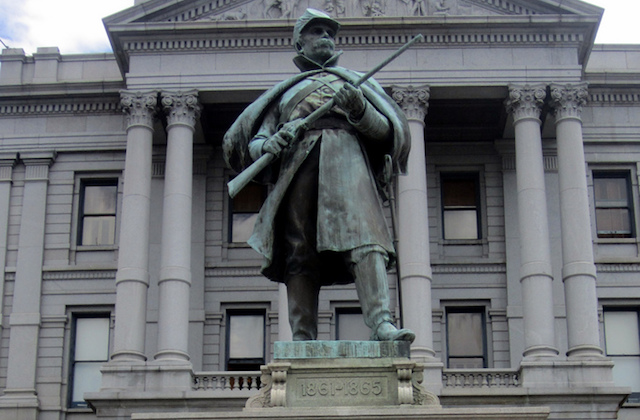Confederate monument debates extend well beyond the South and into places like Arizona and Colorado, two states where Confederate and Union sympathizers fought proxy battles throughout the U.S. Civil War. While Colorado wrestles with the status of its existing six Confederate memorials, an article published by The Nation yesterday (October 26) illuminates the Civil War’s relationship to the so-called "Indian Wars"—and how Coloradans navigate this bloody history today.
The article explores this connection through two still-standing monuments: the Colorado Civil War Memorial statue outside the state capitol in Denver, which honors Union-affiliated soldiers in what was the Colorado Territory; and the Sand Creek Massacre National Historic Site in Kiowa County, which commemorates the 1864 massacre of nearly 200 Cheyenne and Arapaho tribal members by a U.S. volunteer militia. The article explains that militia Colonel John Chivington, an anti-slavery preacher who previously led Union attacks on Confederate supply routes through the New Mexico Territory, permitted his soliders’ to commit horrific acts of violence against Native women:
The [massacre site’s] visitor center makes no attempt to say that there were "very fine people on both sides." Sand Creek was the My Lai of the Plains Wars. The chief of the defenseless camp was friendly to the Whites. Chivington was a fanatical preacher and a murderous psychopath. The brutality was extreme. Chivington’s men, many of whom were falling-off-their-horses drunk, excised the genitals of Arapaho women and displayed them later on the stage of a Denver theater to wild applause.
The article also notes that the Denver Civil War memorial includes Chivington’s name and references Sand Creek as a representative battle—an inclusion which highlights how the Union saw Native genocide as an essential part of their Civil War efforts:
Sand Creek did not just happen at the same time as the Civil War. It, as well as many other mass killings, was seen in the West (and by military commanders in the East) as a function of that war, an auxiliary battlefront. If Chivington’s men were unusually cruel, it was because the intense pressure on the Union Army east of the Mississippi made it necessary to enlist poorly trained and ill-disciplined volunteers in the West.
This legacy carries into the present as Native tribes and Colorado state officials discuss both Confederate and Union memorials. The Denver Post reported in August on how state legislators’ debates about the state’s Confederate monuments drew attention to Native opposition to the Union memorial. "If we’re going to start looking at the designation of racist memorials for people—that’s a good exercise for the society to have, I believe,” said University of Colorado, Denver scholar and American Indian Movement activist Glenn Morris to The Post. “But let’s get serious about it then, because it’s endemic to the fabric of the country.”
Read the full article on thenation.com.
